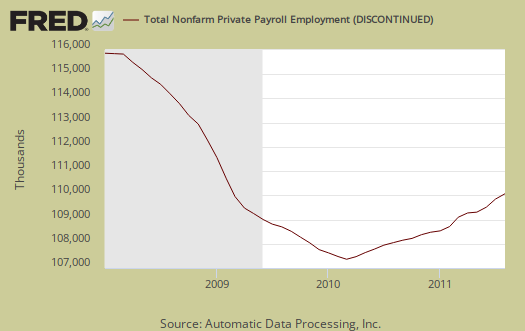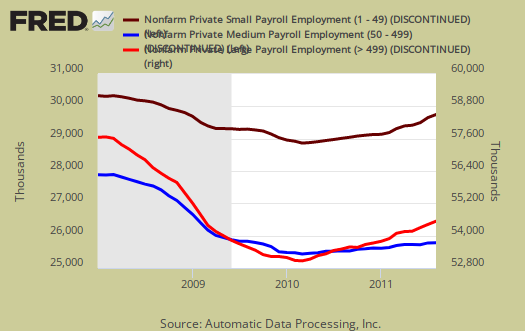ADP, released their proprietary private payrolls August jobs report. This month ADP is reporting a gain of 91,000 private sector jobs in August. July 2011 was revised down to 109,000, from 114,000. In July, the BLS reported 154,000 private sector jobs. ADP implies we should expect to see an uptick in the official unemployment rate, released on Friday. Below are the reported private sector jobs from ADP. This report does not include government, or public jobs.

ADP's numbers claim the service sector created 80,000 jobs while the goods sector gained 11,000 jobs. The manufacturing tab is -4,000 jobs for the month. ADP's professional business services jobs flat-lined, or no growth or decline between July and August. This report, if it matches tomorrow's official unemployment report, is weak job growth. Also,the recent initial unemployment claims reports are past 400,000 and anything above 400,000 in initial claims does not indicate job creation.
Construction finally gained 7,000 jobs and the ADP notes 2,128,000 construction jobs are reported gone since the 1st of January 2007. Their tally for financial services jobs lost since the same date are 687,000. One question which banks refuse to answer: Were these jobs offshore outsourced?
There is a strong mismatch between ADP and the BLS jobs report. To date, the number of private nonfarm payroll jobs ADP reports versus what the BLS reports and on a month-to-month and even cumulative basis do not match. This monthly error is often large, especially when looking at small job growth overall (< 400,000 jobs per month) on a month to month basis.
Below is the cumulative difference between what the ADP reports as the private nonfarm payroll jobs vs. the BLS (ADP minus BLS). This line shows the divergence, over time in number of nonfarm private payroll jobs reported between the two reports. This post will updated to include the August ADP & BLS numbers when released on Friday.

While ADP notes a simple correlation of 0.95, well, a 5% error between monthly reported jobs numbers is an average, and we can see on some months the differences are quite large and around 2008, the difference started to hit about 900,000 jobs.
ADP does use the same seasonal adjustment as the BLS, but their other methodology and even sampling size are different, proprietary. That said, ADP has now put up some details of their methodology to explain the statistical differences between their estimate, the actual mathematics, vs. the BLS. This is new, and good ADP is disclosing their entire methodology so we may get more apples to apples comparisons of the two reports.
Bottom line, the official report, upon which other metrics are based, is the BLS.
All of this said, the reality is the The United States currently needs about 12.7 million jobs to get back to pre-recession levels, taking into account population growth and the labor participation rate back in December 2007. Some estimates are above 20 million jobs needed, right now, to return to full employment levels.
ADP captures jobs by business size and this is worth looking at, especially due to it's relativity within the same report (and methods). In August:
Employment on small payrolls (up to 49 workers) rose 58,000 in August, almost equal to that of last month. Employment on medium payrolls (50 to 499 workers) rose 30,000, while employment on large payrolls (500 or more workers) created only 3,000 jobs.
Below is the graph of ADP private sector job creation breakdown of large businesses (bright red), median business (blue) and small business (dark red). For large business jobs, the scale is on the right of the graph. Medium and Small businesses scale is on the left.

This is the same result every month. Large business, who lobby Congress for their bad trade deals and labor arbitrage are non-existent for hiring Americans. Notice how large businesses have been declining and the pattern starts just about the time offshore outsourcing and the China PNTR came into effect. Small businesses, on the other hand, have increased employment. May I suggest that small businesses are not international, they are not signing offshore outsourcing contracts and moving jobs to India and China. Multinationals, on the other hand, the below decade trend line clearly shows these so called U.S. corporations have abandoned the U.S. worker, on whole. Earlier, the BEA reported statistics validating the ADP job creation trends by business size.
Here is the June 2011 ADP private sector jobs report overview.

Recent comments